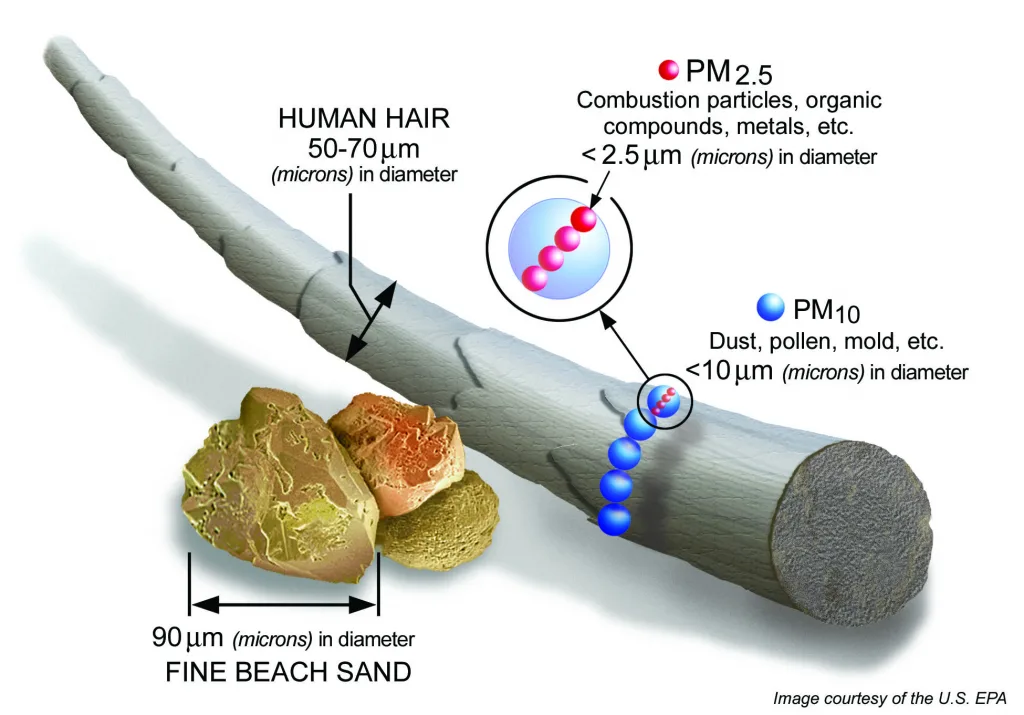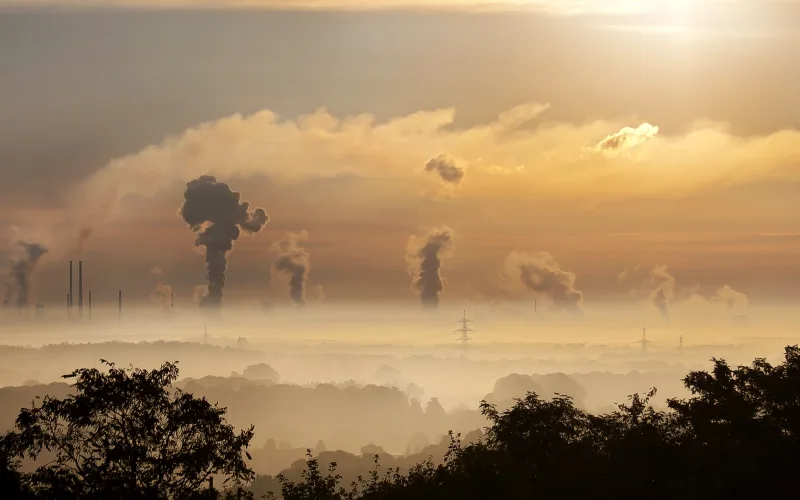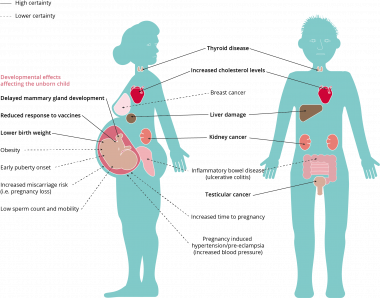Last Updated on August 8, 2025 by Ecologica Life
According to the World Health Organisation, 99% of the world’s population breathes air with high levels of pollutants. The worst exposures are seen in low- and middle-income countries. However, pollution levels in high-income countries still exceed guidelines. Unfortunately, the war in Ukraine has led to an increase in air pollution in the region.
The European Environment Agency has stated that despite a decline in deaths from air pollution in recent years, it is still the biggest environmental health risk in Europe.
Naturally, at Ecologica.life we believe that this is an unacceptable level of pollution for us and all life around us to breathe, and we hope you feel the same.
We will be discussing the current air pollution crisis, its effects, and what we can do to improve the situation.
Table of Contents
What is Air Pollution?
Air pollution is contamination of the indoor or outdoor environment by any chemical, physical or biological agent that modifies the natural characteristics of the atmosphere.
World Health Organisation
There are two types of air pollution: household (indoor) pollution and ambient (outdoor) pollution.
Most of the indoor air pollution comes from sources that emit gases or particles. Air fresheners and building materials, second-hand tobacco smoke and wood-burning stoves release pollutants.
Some indoor air pollutants that have been around for a long time. However, they have often been weakened by outdoor air seeping into the home. Today’s more energy-efficient homes don’t let as much outdoor air in.
How is Air Pollution Measured?
Different countries measure air quality in different ways. The US use the Air Quality Index (AQI), while Europe uses the European Air Quality Index.

Both indices track roughly the same pollutants, with the main difference being the scales used: the AQI goes up to 500, while the European Air Quality Index can go above 1000. These air quality indices measure the concentration of key pollutants such as:
Ground level ozone
You’ve probably heard of the gas known as ozone, which is found in the Earth’s upper atmosphere. The ozone layer is beneficial because it shields people from the sun’s dangerous rays.
However, ground level ozone is harmful to human health. It can damage the central nervous system, cause respiratory and cardiovascular problems, and may have adverse effects on reproduction and development. In 2020, 24,000 people in the EU died prematurely due to ozone exposure.
Ground-level ozone is formed when certain chemical emissions (such as nitrogen dioxide, carbon monoxide and methane) interact in the presence of sunlight. These chemicals can be found in industrial plants, vehicle exhaust, and petrol fumes, among other sources. Ozone pollution is more likely occur during the warmer months.
Carbon monoxide
This gas is produced by from the incomplete combustion of natural gas or other carbonaceous materials. This includes factory emissions, fires, malfunctioning heating systems, and exhaust fumes.
Sulphur dioxide
This is a colourless gas with a pungent, irritating odour. It is produced by smelting sulphur-containing mineral ores and burning fossil fuels. Volcanic eruptions can be a significant natural source of sulphur dioxide emissions.
Nitrogen dioxide
The burning of fossil fuels (coal, gas, and oil), especially in cars, is the largest source of nitrogen dioxide from human activities. In 2020, nitrogen dioxide pollution led to 49,000 premature dates in the EU.
Airborne particles, or aerosols

Airborne particles are usually divided into two types: Particles smaller than 2.5 micrometres in diameter (PM2.5) and particles smaller than 10 micrometres (PM10). It is estimated that in 2020 at least 238,000 people died prematurely in the EU due to PM2.5 exposure.
Construction sites, chimneys, car exhausts, forest fires, volcanoes, sandstorms, and many other places release these particles into the air. These particles can also be created by chemical reactions in the atmosphere.
To you want to find out more about these pollutants and how they affect the body, you can read the AQI brochure.
Causes of Outdoor Air Pollution.
Ambient pollution has a variety of sources and is context specific. Vehicles, power generation, agriculture/waste burning, industry and residential energy for cooking and heating are the main sources of outdoor air pollution.
Low- and middle-income countries have fewer policies on air pollution, which is one of the reasons why they have worse AQIs than higher-income countries.
For higher income countries, for instance in Europe, the main source of particulate matter (40-60%) released in 2020 was from heating buildings with solid fuels. Agriculture was responsible for almost all (94%) of ammonia emissions and 56% of methane emissions. Road transport, agriculture and industry were the main sources of nitrogen oxides.
Effects of Air Pollution
Human health
The WHO estimates that both outdoor and indoor air pollution are responsible for 7 million premature deaths worldwide each year. Ambient air pollution was estimated to cause a 4.2 million premature deaths worldwide in 2016. This was mainly due to the burning of solid fuels (wood, animal dung, charcoal, etc.) in inefficient and highly polluting stoves, leading to the development of respiratory and cardiovascular diseases, as well as cancer.
Particulate matter (airborne particles) has been shown to cause a range of health problems. It has been found at unacceptable levels in both urban and rural areas around the world.
Particulate matter has been shown to increase the risk of stroke, heart disease, lung cancer and acute and chronic respiratory diseases.
Outdoor air pollution disproportionately affects people living in low- and middle-income countries. Of the 4.2 million premature deaths in 2016, 91% occurred in low- and middle-income countries, with the South-East Asia and Western Pacific regions bearing the greatest burden.
As well as causing premature death and poor health, air pollution has a significant financial impact on the healthcare industry.
For example, in 30 European countries, exposure to PM2.5 was associated with 175,702 years lived with disability (YLD) due to chronic obstructive pulmonary disease (COPD) in 2019.
The environment
Global climate and ecosystems are closely linked to air quality. Many of the factors that contribute to air pollution, such as the burning of fossil fuels, are also sources of emissions of greenhouse gases (such as carbon dioxide, nitrous oxide and methane).
Policies to minimise air pollution are therefore a win-win strategy for both the environment and health, contributing to climate change mitigation in the short and long term the near- and long-term while reducing the burden of disease caused by air pollutants.
Air pollution can trigger several downstream environmental problems:
- Acid rain -rainfall that is so acidic that it causes environmental damage, particularly to forests and lakes.
- Eutrophication – a process that causes an overgrowth of algae and plants in lakes, resulting in the death of local fish and wildlife.
- Haze – where dust, smoke and other dry particles reduce visibility and air clarity.
- Damage to ecosystems – exposure to air pollutants can poison wildlife through disruption of endocrine function, organ damage, increased susceptibility to disease, reduced reproductive success and death. According to EEA analysis, 59% of forested areas in the EU were exposed to dangerous levels of ground-level ozone in 2020.
- Stratospheric ozone depletion – The depletion of ozone in the upper atmosphere can lead to increased levels of ultraviolet radiation at ground level. This can increase the risk of cancer, weaken the immune system and affect ecosystems and agricultural productivity.
- Damage to crops and forests – Air pollution has been reported to halve wheat and rice yields. In 2019, 35 European countries suffered economic losses worth €1.4 billion related to the impact of ground-level ozone on wheat yields, with France, Germany, Poland, and Turkey suffering the greatest losses.
How To Reduce Air Pollution?
Cooking with open fires or inefficient stoves using kerosene, biomass (wood, animal dung, and crop waste) or coal is a major contributor to indoor pollution. An estimated 2.4 billion people (around one-third of the world’s population) cook using these methods.
The WHO offers guidance on what is considered best practice for household fuel burning. The WHO stresses the importance of not using unprocessed coal and kerosene as household fuels.
Ventilate your home properly and open more windows on clear days to improve indoor air quality. If possible, don’t use wood-burning stoves and fireplaces. Smoking outdoors rather than indoors also reduces exposure to second-hand smoke for smokers and their families, reducing the risk of lung disease.
Outdoor pollution is more difficult for individuals to control. In the short term, we can do things like use transport that produces less air pollution. But real change can only come from coordinated efforts by policymakers at local, national and regional levels, whose policies can affect sectors such as agriculture, urban planning, waste management, energy and transport.
The first step in improving outdoor air quality is first to measure it. Europe and North America are very good at this, but governments in Africa, Central Asia and Latin America need to improve air quality measurement.
Low-cost air quality monitors are relatively easy to deploy and governments in these areas should adopt legislation making monitoring a legal requirement while investing in existing infrastructure to do so.
If you would like to reduce air pollution in your area, you can try get actively involved in local legislation. Additionally, you can try to reduce your carbon footprint.
What Is Being Done in Europe?
The EU is leading by example in tackling the causes of air pollution. In the EU, the number of premature deaths due to PM2.5 exposure fell by 45% between 2005 and 2020.
The European Commission proposed a revision of the Ambient Air Quality Directive in October 2022 that include stricter pollution thresholds, an improved right to clean air (possibly including provisions for citizens to seek compensation for health damage caused by air pollution), stronger air quality monitoring rules and better public information.
If the current trends continue, the EU is expected to meet the Zero Pollution Action Plan target of a 55-66% reduction in premature deaths from air pollution by 2030 compared to 2005 levels, leading to overall GDP growth, with the benefits of clean air policies outweighing the costs.
However, additional efforts will be needed to achieve the zero pollution vision for 2050, which calls for air pollution to be reduced to levels that are no longer considered harmful to human health.
Examples of successful policies can be found on the WHO website. So, make sure you put pressure on your local politicians to pass laws that put our air quality and environment first.
How to Check Air Pollution in Your Area
There are several websites where you can check the air quality in your area. The World Air Quality Index website provides real-time information on air quality around the world. Alternatively, you can access the European Air Quality Index.
There is a lot of air pollution in my area, what should I do?
If the air in your area scores poorly on the AQI, try to spend less time outside. If you do go outside, try to reduce prolonged exercise (light or moderate exercising for several hours) and heavy exercise (exercise that makes you breathe hard). You can substitute jogging for example for walking.
If you experience unusual coughing, chest discomfort, wheezing difficulty breathing or unusual tiredness, you should reduce your activity level.
Who is most at risk?
- People with lung diseases, such as asthma, chronic bronchitis, and emphysema.
- Children.
- Older adults.
- People with heart disease.
What are your thoughts on this article? Do you have any ideas for other topics we should be covering? Leave us a suggestion, we appreciate all the feedback we get!








